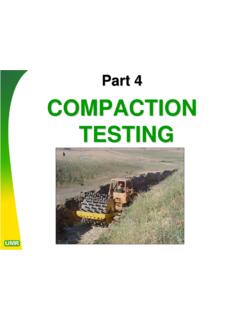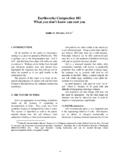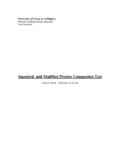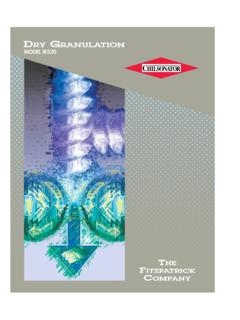Transcription of Soil-Processing and Compaction - sweethaven02.com
1 Soil-Processing and Compaction 11-1 Chapter 11 Soil-Processing and CompactionHorizontal construction projects such as roads and airfields areconstructed using a variety of soil types. The suitability of these materialsfor construction applications depends on their gradation, physicalcharacteristics, and load-bearing capacity. While some soil types aresuitable for structural purposes in their natural state, others requireprocessing such as adjusting the moisture content by mixing and there is a direct relationship between increased density andincreased strength and bearing capacity, the engineering properties ofmost soils can be improved simply by Compaction .
2 soil properties andcompaction requirements are discussed in FM PROCESSING11-1. The amount of water present in a soil mass affects the ease ofcompaction operations and the achievable soil density. The water-contentratio is the standard measure of water in a soil mass. The water-contentratio compares the weight of the water present in a soil mass to the weight ofthe soil solids in the same mass. Each soil has its particular optimummoisture content (OMC) at which a corresponding maximum density can beobtained for a given amount of compactive input energy. Trying to compact asoil at a water content either higher or lower than optimum can be verydifficult.
3 The OMC varies from about 12 to 25 percent for fine-grained soilsand from 7 to 12 percent for well-graded granular soils. Since it is difficult toattain and maintain the exact OMC, normal practice is to work within anacceptable moisture range. This range, which is usually 2 percent ofoptimum, is based on attaining the maximum density with the minimumcompactive effort. Determination of the OMC is a laboratory test a detailed description of the moisture-density relationships of varioussoils, refer to FM THE MOISTURE CONTENT11-2. If the moisture content of a soil is below its optimum moisture range,add water to the soil before Compaction .
4 When it is necessary to add water, theproject officer must consider the following: The amount of water required. The rate of water application. The method of application. The effects of the 5-43411-2 Soil-Processing and CompactionAdd water to the soil at the borrow pit or in place (at the construction site).When processing granular materials, adding water in place usually gives thebest results. After adding water, thoroughly and uniformly mix it with the of Water Required11-3. It is essential to determine the amount of water required to achieve asoil water content within the acceptable moisture range.
5 Compute the amountof water to add or remove in gallons per station (100 feet of length). Use thefollowing formula, based on the compacted volume, to compute the amount ofwater to add or remove from the soil . The volume in this formula is for onlyone station of project length. The computation is based on the dry weight ofthe = the weight of a gallon of waterNOTE: Normally, it is a good practice to adjust the desired moisturecontent to OMC +2 percent, but this depends on the environmentalconditions (temperature and wind) and the soil type. A negativeanswer indicates that water removal from the borrow material is nec-essary before compacting the material on the : If the road width is constant, determine the total amount ofwater required for the job by multiplying the gallons per lift times thenumber of lifts, times the road length (in stations).
6 Gallons per station for one liftdesired dry density of soil in pounds per cubic foot (pcf)desired moisture content (percent) moisture content of borrow (percent) 100------------------------------------- ---------------------------------------- ---------------------------------------- ---------------------------------------- ---------------------------------------- ------------- compacted volume of soil (cubic foot) pounds per gallon---------------------------------- ---------------------------------------- ---------------------------------- =EXAMPLEP repare to place soil in 6-inch (compacted) lifts.
7 The desired dry unit weight of theembankment is 120 pcf. The OMC (desired moisture content) of the soil is 12 per-cent, but the soils technician has determined that the moisture content of the bor-row material is only 5 percent. The roadway section to be placed is 40 feet the amount of water (in gallons) to add per station for each lift of per station for one lift120 pcf12 percent (OMC) 5 percent (borrow) 100------------------------------------- ---------------------------------------- ------------------------------- 40 feet 100 feet foot pounds per gallon---------------------------------- ---------------------------------------- - 120 pcf 2,000 cubic pounds per gallon---------------------------------- ------------------------------- 2,017===FM 5-434 Soil-Processing and Compaction 11-3 Rate of Water Application11-4.
8 After determining the total amount of water required, determine therate of application. Use the following formal to determine the waterapplication rate in gallons per square 9= factor used to convert square feet to square = the weight of a gallon of waterMethod of Application11-5. After calculating the application rate, determine the method ofapplication. Regardless of the method of application, it is important to achievethe proper application rate and the uniform distribution of Water Distributor. The most common method of adding water is witha water distributor. Water distributors are designed to distribute the correctamount of water evenly over the fill.
9 The truck-mounted, 1,000-gallon waterdistributor (Figure 11-1, page 11-4) can distribute water under variouspressures or by gravity feed. It distributes the water through a 12-foot folding,rear-mounted spray bar. The spray bar is adjustable, in 1-foot increments,from 4 to 24 feet. The water application rate can be maintained by controllingthe forward speed of the vehicle and the water distribution pressure. A cab-mounted odometer shows the vehicle speed in fpm. The project officer shouldprovide the water-distributor operator with the application rate in gallons persquare yard.
10 With this information, the operator can determine theappropriate spray-bar length, pumping pressure, and vehicle speed to achievethe required application rate. Refer to the vehicle s technical manual forspecific information regarding application per square yarddesired dry density of soil (pcf)percent of moisture added or removed100------------------------------ ---------------------------------------- --------------------------------------- lift thickness (feet) 9 square feet per square pounds per gallon---------------------------------- ---------------------------------------- --------- =EXAMPLEU sing the data from the previous example, determine the required application ratein gallons per square per square yard120 pcf foot 9 square feet per square pounds per gallon---------------------------------- ---------------------------------------- --------- gallons per square yard==FM 5-43411-4 Soil-Processing and CompactionFigure 11-1.








